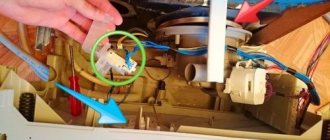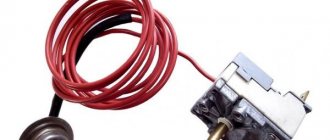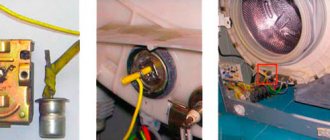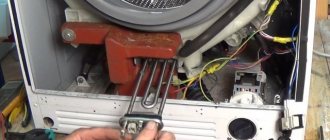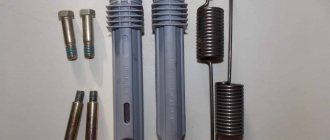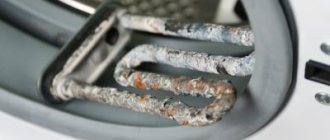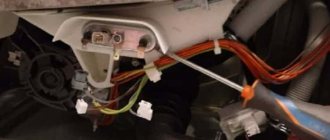The temperature sensor is one of the main and important elements of the washing machine - it is responsible for heating the water to the required temperature, and then the temperature sensor turns off.
If you notice that your washing machine “overheats” the water very much or, on the contrary, does not heat it at all, then the problem lies precisely in the temperature sensor. In our article you will learn how to check the temperature sensor for its functionality and for replacement (if required).
Purpose and types of temperature sensors
The task of this element of the washing machine circuit is to control the temperature of the water in the tank. The sensor measures parameters in real time, transmits information to the control module, which in turn analyzes the data and, if necessary, gives the command to turn on the heating element.
Modern washing machines can be equipped with three types of sensors. Each of them has its own characteristics, advantages and disadvantages. These are: a bimetallic element, a gas-filled temperature sensor and an electronic thermistor sensor.
Bimetallic element
This is a purely mechanical device. The moving element of the sensor is a plate made of two metals, one of which has a significantly higher coefficient of thermal expansion. When the set temperature is reached, the plate bends and closes or opens the contacts.
Exactly the same element is used in irons, cheap convectors and other heating equipment with a temperature measurement function. The sensor is simple and fairly reliable, but has low accuracy and often fails due to oxidation of the contacts.
Gas-filled sensor
A temperature sensor of this type consists of a sensor itself with a sealed tube filled with gas, a temperature controller and a conductor that connects them. The sensor is installed in the tank; when the temperature changes, pressure arises, which acts on the membrane, closes and opens the contacts, turning the heating element on and off. Such temperature sensors are found in older Indesit washing machines.
This temperature sensor is distinguished by a fairly high accuracy of temperature measurement, but it is difficult to manufacture and prone to breakdowns. The slightest damage to the tube leads to a complete loss of functionality and the need to replace the sensor.
Thermistor
Unlike previous types, this is a completely electronic element. In modern washing machines, it has almost completely replaced mechanical parts. Found in almost all washing machines Samsung, Bosch and others. The temperature sensor is easy to change (it is installed directly next to the heating element). Structurally, it is a metal cylinder with a diameter of about 10 mm. There is a connection block for connecting to the wiring.
The operation of a temperature sensor is based on the effect of reducing its resistance when the ambient temperature changes. The absence of moving elements ensures a long service life, and electronic filling guarantees high accuracy of indicators.
Variety of temperature sensors
An automatic washing design can be equipped with only one of the following three temperature sensors :
- Bimetallic;
- Thermistor;
- Gas-filled.
The bimetallic temperature sensor looks like a tablet, approximately 20-30 millimeters in diameter and 10 millimeters in height. Inside this small tablet is a bimetallic strip. During the process of heating water, when it reaches a certain temperature, the plate bends and creates a closure of the contacts. Under this condition, the heating process is completed.
The thermistor has become a fairly popular element among modern washing designs, which has replaced the temperature sensor.
The thermistor looks like a small elongated cylinder. Its diameter is about 10 millimeters, and its length reaches about 30 millimeters. This cylinder is attached directly to the heating element. The principle of operation of such an element does not involve any mechanical work of the part, but simply changes the resistance during the process of heating the water to the temperature you need.
A gas-filled temperature sensor has only two parts: the first is a tablet made of metal with a diameter of approximately 20-30 millimeters and a height of about 30 millimeters.
The first element is mainly located inside the tank itself, and is always touching the water to change the temperature. The second part of the temperature sensor is made in the form of a copper tube, which is connected to the temperature controller (external), which is located on the control panel of the washing machine. Inside these elements there is a gas, the name of which is freon. Under the temperature of the water, this gas can compress or expand, thereby forming contacts that lead to the heating element.
Symptoms of a faulty temperature sensor
Most automatic washing machines from renowned manufacturers, for example, Bosch, can themselves detect a malfunction of the temperature sensor. If it breaks down, a code is displayed on the display, which allows you to accurately identify the source of the malfunction. In addition, the following symptoms indicate sensor failure.
- When performing any program, the water temperature rises to almost boiling.
- Body parts get hot, and in some cases steam appears in the area of the loading hatch.
- The heating element does not turn on, the washing machine does not heat the water at all.
The appearance of an error code on the screen, as well as any of the signs of failure described above, is a reason to start repairs. You should not delay, since a violation of the temperature regime entails not only damaged laundry, but also damage to a number of parts of the washing machine.
Signs and causes of malfunction
The following signs indicate a thermostat malfunction:
- the water is heated to a boil, regardless of the set temperature limit mode;
- strong heating of the machine body during washing, hot steam from under the lid;
- the water does not heat up at all, although the electronic control records the temperature.
The cause of failure of the bimetallic thermostat is physical wear and destruction of the plate. In this case, the plate does not bend and the water heating does not turn off.
The gas-filled thermostat does not work due to a leak in the tube and evaporation of freon from the system. You can repair the thermostat by replacing the tube or restoring the tightness, as well as filling the system with freon.
Thermistors rarely fail. The cause may be a manufacturing defect.
Partial disassembly of the washing machine
The temperature sensor measures the temperature of the water in the tank, therefore, it is attached to its body. To gain access to it, you will need to partially disassemble the washing machine. The easiest way to work is with new models in which the sensor is a thermistor; to check and replace it, just remove the back panel.
Before starting work, you must unplug the washing machine from the socket. Next, disconnect the inlet and outlet hoses. They need to be handled with care; there is probably some water left inside that could spill onto the floor.
The washing machine is moved away from the wall; it is better to place it in the middle of the room. The work is performed according to the following algorithm:
- Unscrew the screws holding the back wall;
- remove the panel, put it aside;
- loosen the screw holding the heating element;
- remove the temperature sensor.
This instruction is relevant in the case of a washing machine with a thermistor, these are new models Samsung, Ariston, Indesit and others. Finding and retrieving sensors in older washing machines has its own characteristics, which will be discussed below.
Types of thermostats
There are 3 types of thermostats:
- Gas-filled. They consist of a sensor, a can with a tube filled with freon, and a control device. As the water temperature rises, the gas expands and presses on the plate, which opens the contacts and disconnects the heating element from the network.
- Bimetallic. Such thermostats are located inside a drum in heated water. The operating principle is based on closing (opening) the contact when heating (cooling) the bimetallic plate.
- Thermistors. New models of machines use thermistors that send a signal to the control board that turns off the heating element. The operation of such sensors is based on changes in the resistivity of the material when heated. Structurally, such a device is much more reliable, because has no mechanical circuit.
Thermistor check
The electronic temperature sensor changes resistance when the ambient temperature changes, this is exactly what you should make sure of. You need a multimeter to work. You need to do the following:
- disconnect the wires from the sensor;
- remove it from the socket;
- switch the device to the resistor testing position;
- check the resistance with a multimeter (the normal value at room temperature will be about 6 kOhm);
- lower the thermistor into hot water;
- re-measure.
At approximately 50 degrees, the thermistor resistance should be below 1.5 kOhm. If the value is constant or if the device shows a “gap”, the sensor is changed. Installation is carried out in the reverse order, the back wall of the washing machine is attached last.
If a breakdown is not detected, the cause of the malfunction may be a burnt heating element.
Removing and checking the gas-filled temperature sensor
Owners of an older Indesit or LG washing machine may encounter another type of sensor, the working part of which is a tube filled with gas. To remove and check such a temperature sensor, you will first have to dismantle the front panel of the machine and disconnect the regulator.
Further, along the wires coming from the regulator, it is easy to detect the sensor itself. It is mounted on the drum, but the exact installation location depends on the manufacturer and model; before starting work, you should read the disassembly manual for your specific washing machine.
To check this temperature sensor, you also need a multimeter. It is transferred to the “ringing” mode. Set the temperature switch to 45-50 degrees. The sensor is immersed in hot water and the moment of contact activation is recorded.
The faulty temperature sensor is replaced. Sensors and kits that also include a regulator are sold separately. It is better to change the pair, this will guarantee a long service life of the washing machine and protect against unscheduled repairs.
Normal indicators of sensors of different SMs
The range of models and brands of automatic cars is large. Manufacturers equip them with various sensors. Here are the characteristics of the most common ones:
- Appliances from AEG, Zanussi and Electrolux brands (EWM 1000 PLUS and 2000): The temperature sensor resistance must be maintained at 6.0 kOhm. After heating to +800 C it drops to 0.5 - 0.7 kOhm. For Electrolux machines manufactured in the EWM 1000 series, the indicators should be different: at room temperature - 17 kOhm, when it increases to +850 C - 2.1 kOhm - 2.5 kOhm.
Important! Here and below, resistance values for temperature sensors of all equipment models are given for room temperature. For some brands, heating indicators are indicated separately.
- Candy washing machines: the multimeter detects a resistance of 27.0 kOhm.
- Devices from Siemens, Hansa, Bosch brands: the temperature sensor resistance should normally be about 4.8 kOhm.
- Machines produced by the brands Atlant, Beko, Ardo have a temperature sensor resistance of 5.6 to 5.8 kOhm at a temperature of +220 C. At the same time, some models of the Ardo brand have higher values, about 21.5 kOhm.
- ASKO brand equipment most often demonstrates the following indicators: for separately installed sensors, the resistance ranges from 40 to 60 kOhm, in some devices - 20 kOhm. The temperature sensors that are installed in heating elements differ from previous models; their resistance should be at the level of 13 kOhm.
- For most models of Samsung washing machines, the manufacturer specifies 12 kOhm.
- Equipment from the Ariston and HOTPOINT/ARISTON brands, as well as Indesit, differ in the resistance parameters of temperature sensors. For these models, about 20 kOhm is considered the norm. Separately installed devices are available at 200 kOhm.
- When measuring the resistance of temperature sensors, Whirpool automatic machines should show a result of 35.9 kOhm. In some models, the indicators differ and may be about 12 kOhm.
- Models produced under the Brandt and Thomson brands have a sensor resistance at a temperature of +200 C at 50 kOhm.
- Equipment manufacturer LG also produces temperature sensors with values of about 50 kOhm.
The parameters given here characterize the most common brands and models. However, when replacing a sensor, you cannot be completely sure that a part with the specified resistance will be suitable for a particular washing machine . To make the right choice, you should contact an experienced professional.
Checking the bimetallic element
Sometimes you can encounter mechanical type temperature sensors; the procedure for checking them is similar to the procedure for working with gas-filled sensors, but the difficulty lies in finding and removing the element itself.
Exactly as in the previous case, the sensor is removed, tested for contact, and then immersed in hot water. By the way, a bimetallic temperature sensor can be checked without a multimeter. Due to its design, it clicks quite loudly when triggered, however, it is better to use the device; often the sensor does not trigger due to oxidation of the contacts, this cannot be determined by ear.
Despite the obvious complexity of a modern automatic washing machine, most of its breakdowns can be fixed independently. Replacing the temperature sensor is no exception. It is easy to check and replace if necessary. It is important only to buy original replacement sensors; an attempt to save money may become a reason for repeated repairs.
How to ring a heating element with a multimeter
If the readings of the temperature sensor turned out to be correct when checking it, and the washing machine still washes in cold water, then the heating element needs to be checked with a multimeter. It is quite simple to check the heating element with a tester; to do this, you need to remove the wires from it, set the multimeter to measure the minimum resistance and ring the heater contacts with probes.
The resistance of the water heater should be 25-35 Ohms. Afterwards, you need to check for a possible breakdown in the housing.
To do this, set the multimeter to the maximum resistance measurement values, touch any of the contacts of the part with one probe, and its body with the other.
With an intact case, the resistance on the tester will be equal to unity. To check the heating element for breakdown of the housing, it is necessary to first keep it in water for some time; a dry heater can show positive measurement results.
A faulty heater must be replaced to ensure proper operation of the washing machine and to avoid electrical shock to users of the appliance. Most modern washing machines recognize a breakdown that occurs on the body of the washer and turn off the program.
Also, if there is an RCD in the power supply circuit of the washing machine, then this device completely de-energizes the outlet at the slightest breakdown of electricity on the product body. This can also occur due to the use of electrical appliances in poorly ventilated areas or in high humidity.
